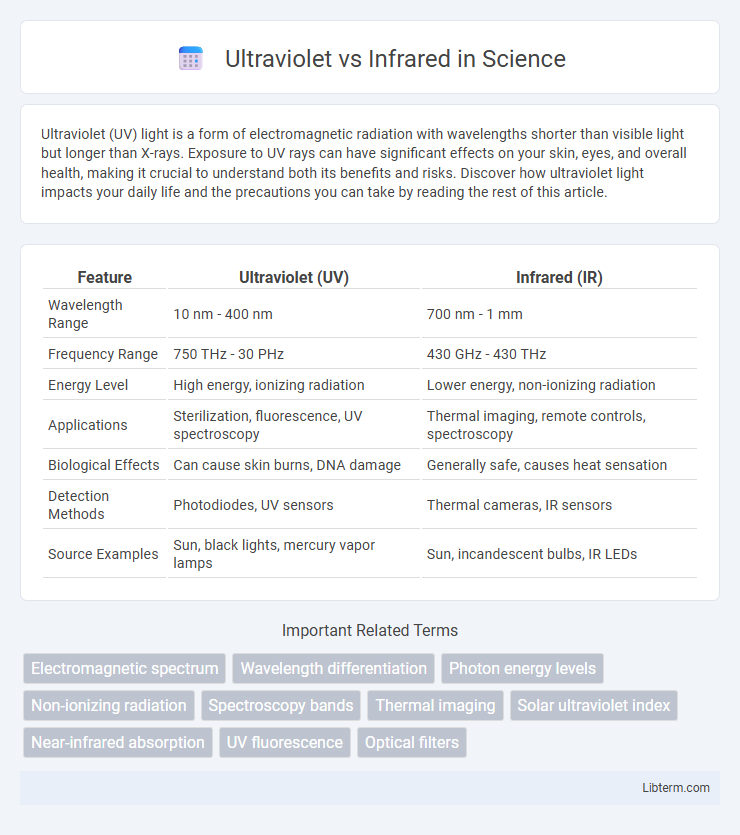Ultraviolet (UV) light is a form of electromagnetic radiation with wavelengths shorter than visible light but longer than X-rays. Exposure to UV rays can have significant effects on your skin, eyes, and overall health, making it crucial to understand both its benefits and risks. Discover how ultraviolet light impacts your daily life and the precautions you can take by reading the rest of this article.
Table of Comparison
| Feature | Ultraviolet (UV) | Infrared (IR) |
|---|---|---|
| Wavelength Range | 10 nm - 400 nm | 700 nm - 1 mm |
| Frequency Range | 750 THz - 30 PHz | 430 GHz - 430 THz |
| Energy Level | High energy, ionizing radiation | Lower energy, non-ionizing radiation |
| Applications | Sterilization, fluorescence, UV spectroscopy | Thermal imaging, remote controls, spectroscopy |
| Biological Effects | Can cause skin burns, DNA damage | Generally safe, causes heat sensation |
| Detection Methods | Photodiodes, UV sensors | Thermal cameras, IR sensors |
| Source Examples | Sun, black lights, mercury vapor lamps | Sun, incandescent bulbs, IR LEDs |
Understanding Ultraviolet and Infrared Radiation
Ultraviolet (UV) and infrared (IR) radiation are types of electromagnetic waves with wavelengths beyond the visible spectrum; UV radiation ranges from 10 nm to 400 nm, while IR radiation extends from 700 nm to 1 mm. UV radiation carries higher energy capable of causing chemical reactions and skin damage, whereas IR radiation primarily transfers heat energy and is used in thermal imaging and remote controls. Understanding the differences in wavelength and energy helps explain their distinct applications in medical, industrial, and environmental fields.
Wavelength Differences: Ultraviolet vs Infrared
Ultraviolet (UV) radiation has a shorter wavelength range of approximately 10 to 400 nanometers, positioned just beyond the visible violet light spectrum, making it more energetic and capable of causing photochemical reactions. Infrared (IR) radiation spans a longer wavelength range from about 700 nanometers to 1 millimeter, situated beyond visible red light and primarily associated with thermal energy emission and heat detection. The fundamental distinction in their wavelengths directly influences their applications, with UV utilized in sterilization and fluorescence, while IR is critical in thermal imaging and remote controls.
Sources of Ultraviolet and Infrared Light
Ultraviolet light originates primarily from the sun, fluorescent lamps, and UV LEDs, which emit high-frequency electromagnetic waves with wavelengths ranging from 10 to 400 nanometers. Infrared light is commonly produced by the sun, incandescent bulbs, and thermal imaging devices, with wavelengths between 700 nanometers and 1 millimeter that are associated with heat emission. Both ultraviolet and infrared sources play crucial roles in scientific applications, from sterilization and fluorescence to thermal sensing and communication technologies.
Applications in Science and Technology
Ultraviolet (UV) radiation is widely used in sterilization, fluorescence spectroscopy, and photolithography for semiconductor manufacturing, enabling precise microfabrication and biological research. Infrared (IR) technology is essential in thermal imaging, remote sensing, and optical communication, facilitating temperature measurement, environmental monitoring, and data transmission. Both UV and IR wavelengths play crucial roles in scientific instrumentation, enhancing capabilities in fields such as astronomy, medical diagnostics, and materials analysis.
Health Effects: Benefits and Risks
Ultraviolet (UV) radiation aids vitamin D synthesis, strengthening bones and immune function, but excessive exposure causes skin cancer, sunburn, and eye damage. Infrared (IR) radiation promotes blood circulation, reduces muscle pain, and supports wound healing, though prolonged exposure risks thermal burns and skin aging. Balancing UV and IR exposure is crucial for maximizing health benefits while minimizing adverse effects.
Detection and Measurement Methods
Ultraviolet detection commonly relies on photodiodes, photomultiplier tubes, and spectrophotometers that measure wavelengths between 10 nm and 400 nm, capitalizing on the material's photon absorption properties. Infrared measurement utilizes thermal detectors such as thermopiles, bolometers, and quantum detectors sensitive to wavelengths from 700 nm to 1 mm, often capturing emitted radiation related to temperature variations. Both methods require calibration with standards like blackbody radiation sources for infrared and deuterium lamps for ultraviolet to ensure precision in quantitative analysis.
Role in Astronomy and Space Exploration
Ultraviolet (UV) and infrared (IR) wavelengths play crucial roles in astronomy and space exploration by revealing different cosmic phenomena. UV observations uncover hot, young stars and energetic processes such as star formation and supernovae remnants, while IR penetrates dust clouds, allowing the study of cooler objects like protostars and planetary systems obscured in visible light. Space telescopes like the Hubble Space Telescope (UV) and the James Webb Space Telescope (IR) leverage these wavelengths to provide comprehensive insights into galaxy evolution, cosmic structure, and planetary atmospheres.
Impact on the Environment
Ultraviolet (UV) radiation from the sun contributes to the formation and breakdown of ozone in the stratosphere, influencing climate and protecting ecosystems by filtering harmful rays. Infrared (IR) radiation plays a critical role in the greenhouse effect, as greenhouse gases absorb IR energy, trapping heat and driving global warming. Both UV and IR radiation impact biodiversity and ecosystem balance, with UV potentially causing DNA damage in living organisms while IR affects temperature regulation essential for habitat stability.
Everyday Uses and Innovations
Ultraviolet (UV) light enhances water purification, sterilization of medical instruments, and counterfeit detection in currency, leveraging its germicidal properties. Infrared (IR) technology powers thermal imaging cameras, remote controls, and energy-efficient heating systems by detecting heat radiation invisible to the human eye. Innovations in UV and IR applications continue to improve smart home devices, healthcare diagnostics, and environmental monitoring.
Future Trends in Ultraviolet and Infrared Research
Future trends in ultraviolet and infrared research emphasize advancements in sensor technology, enabling higher sensitivity and broader wavelength detection for applications in medical diagnostics, environmental monitoring, and communications. Emerging materials like graphene and perovskites are revolutionizing UV and IR photodetectors by enhancing efficiency and flexibility. Integration of AI-driven data analysis with UV and IR imaging is accelerating progress in real-time monitoring and precision sensing across industries.
Ultraviolet Infographic

 libterm.com
libterm.com